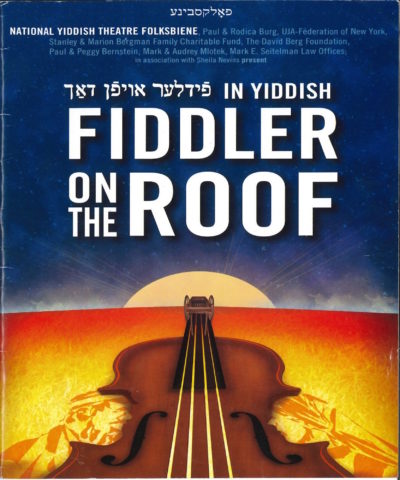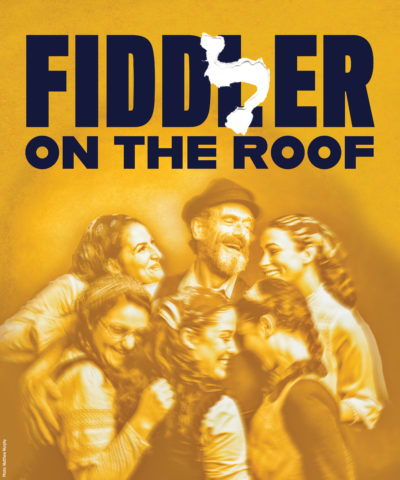In 2014, I conceived of a 50th Anniversary Fiddler on the Roof celebration at Town Hall as the National Yiddish Theatre Folksbiene’s (NYTF) yearly gala fundraiser. We gathered together over 100 alumni of the original Broadway production including Joanna Merlin, and Austin Pendelton, as well as alumni of the film, including Topol, Roz Harris and Neva Small and others from other productions in the last 50 years.
I first heard the Israeli cast recording of Fiddler on the Roof in Yiddish in 1966 in my parents’ apartment in the Bronx. By then I was already musically directing shows in camps and school.
Fast forward a few years—as Artistic Director of NYTF I was thinking about what Yiddish production would resonate amongst the widest audience. The idea of Fiddler was always in my head.
Back to the 50th Anniversary—I first went to Sheldon Harnick, the original lyricist, with whom I have a relationship, and asked him for his approval with the concept. I had accompanied him in concert various times—and he had graciously appeared for us at previous benefits. He gladly agreed. I also contacted Elisa Stein, the widow of Joe Stein the writer, and she also said “Go for it.” Lastly, I contacted Hal Prince, the legendary director and producer, and asked for a meeting about this topic. We met at Prince’s Rockefeller Center offices for about an hour as he told me the history of Fiddler from his vantage point. He recommended some people I should speak with to get involved—and was wholeheartedly supportive of the idea.
We assembled over one hundred artists who had appeared in the Broadway original, in the film, or in other important revivals, including Topol. (Ellen and Peter Weintraub, dear friends and supporters of the theater, were instrumental in connecting me with Topol and getting him here, including covering the cost of his travel.) Others to appear were the internationally-acclaimed violinist Joshua Bell, who performed a Fiddler fantasy.
Understanding that any new production of Fiddler would be compared to the many Broadway versions of Fiddler that thousands of people have seen, I knew our production would have to stand up to the other versions that people knew and loved.
In mid-2017, after putting together a budget and a cast list with our team, we saw we were dealing with the largest cast the NYTF ever assembled. I knew that it would require a version of the original orchestrations which were and are an integral part of the success of the musical score.
We managed to get the cast down to twenty-six people, which was very tight considering there are multiple characters. I looked at the various alternatives to the orchestration and Music Theatre International (MTI) had a smaller orchestration available based on the original orchestrations for twelve people (as opposed to nineteen minimum but usually twenty-five players). This was created by Larry Blank, with whom I would work later in producing the original cast recording.
The most important step I took was to pick a director. I realized that the ‘story’ of presenting Fiddler in the language from which the original stories by Sholom Aleichem were based would attract much attention. The project had the financial potential to be successful. I consulted with both Hal Prince and Sheldon Harnick about picking a director. I had had some contact with Joel Grey before , so I mentioned his name to Hal Prince. Hal, who is good friends with Joel after directing him in Cabaret (for which won Joel his first Tony Award) wrote back to me that he thought Joel would be a terrific choice.
I wrote to Joel and asked him if he would either be interested in playing Tevye (the main character), or in directing the first-ever professional Yiddish version of Fiddler on the Roof to be presented in America.
He wrote back that he was in fact interested in directing, although he didn’t really know Yiddish. I had assumed that he knew some Yiddish because of his father’s work and recordings. Mickey Katz, Joel’s father, was a celebrated klezmer clarinetist, parody writer, and band leader, who recorded several albums of Yiddish parodies, that became bestsellers in the 1950s and ’60s.
I met with Joel the next day at a cafe near his apartment in the West Village .
He told me of his history with Fiddler, having been invited by Hal Prince to come see the show in out-of-town previews in Washington DC in 1964 before it opened in NY. He had fallen in love with it then—but he didn’t know (enough) Yiddish. I assured him that we, the NYTF, had coaches that would help with the Yiddish, and that in the same way opera directors don’t always speak Italian, German, or French, they too direct operas in other languages.
We discussed concept and arranged for him to come down to see the theater and have another meeting there. It was there after seeing the theater, he decided that this production would have to be unique in its approach, not only because of the Yiddish, but because of the limited resources of the theater (stage size, lights, etc. ). We began the formal work of contracting him to direct our production which meant going into rehearsal in June 2018 and open for previews on July 4, 2018. We had booked the theater with the museum for an initial 8-week run.
The next most important person in the team would be the choreographer. Joel had some ideas of people he had worked with but for various reasons they were not available.
I had consulted with Allan Greenberg, a trustee of the Jerome Robbins Foundation, who recommended some people to speak with, specifically Sammy Bayes, who was Jerome Robbins’s assistant in the original production of Fiddler and who had gone on to direct and choreograph many subsequent productions through the years. He also recommended Stas Kmiec, a choreographer and alumnus of Fiddler, having performed in it as a dancer over fifteen-hundred times though the years, and had also choreographed it. Stas was of Polish descent and was very interested in not only honoring the Robbins legacy but adapting the dance, infusing it with authentic Polish and Jewish folk dance to heighten the authenticity of the project.
Joel and he met and they hit it off immediately and Stas was engaged to do the musical staging and choreography for our production.
I believed that with Stas’s knowledge of the staging of Fiddler (having been a part of it for so many times) and with Joel’s passion for and knowledge of the piece, they would contribute much to the production’s success.
Joel contacted designers he knew from his Broadway world and brought them down to The Museum of Jewish Heritage to see the theater, sit and have a bite in the Museum’s Lox Cafe, and appreciate the view of the Statue of Liberty and Ellis Island, hoping that would resonate for them as they considered teaming up with Joel to mount this production.
The set designer Beowolf Beorit, costume designer Ann Hould Ward, lighting Designer Peter Kaczorewski, and sound designer Dan Moses Schreier are all Tony winners and all found the project fascinating.
We announced the production in an Arts Briefly post in The New York Times and they found it newsworthy enough to include a picture of Sheldon Harnick. From that announcement, our casting director, Jamibeth Margolies received over twenty-five hundred inquiries from actors interested in auditioning for this production with Joel directing. We scoured through them and picked seven hundred that we would invite to audition.
We asked them to sing something from their repertoire for us to see and hear them at their best, and then we asked them to prepare some Fiddler material in Yiddish so that we could see what they could do with the Yiddish in the few days they had to prepare for the auditions.
Present at the auditions were Joel Grey, Stas Kmiec, and Motl Didner, the NYTF’s Associate Artistic Director who would also serve as Yiddish coach. Jamibeth Margolies, the audition pianist, and myself were there as well.
I had prepared the vocal score with permission of course from MTI who controls the rights. Under each line of music I entered the Yiddish transliteration into English letters, and under that line we put a word-for-word English translation. I put in the original Sheldon Harnick lyric, so they knew the original and the rhyme scheme. This is how opera singers learn their Italian or German arias, by putting in the translations of each word under each note.
We also made voice-recordings with Motl reading the Yiddish text slowly, and I made vocal recordings of the songs so they could hear the Yiddish scan into the music.
No one had expectations of the success Fiddler on the Roof in Yiddish would eventually have! As I sit here in December 2019, the show is preparing to close on January 5, 2020, having played uptown at Stage 42, formerly the Little Shubert Theater, on 42nd Street, since its transfer uptown last February.


